This article was co-authored by Chris M. Matsko, MD. Dr. Chris M. Matsko is a retired physician based in Pittsburgh, Pennsylvania. With over 25 years of medical research experience, Dr. Matsko was awarded the Pittsburgh Cornell University Leadership Award for Excellence. He holds a BS in Nutritional Science from Cornell University and an MD from the Temple University School of Medicine in 2007. Dr. Matsko earned a Research Writing Certification from the American Medical Writers Association (AMWA) in 2016 and a Medical Writing & Editing Certification from the University of Chicago in 2017.
There are 17 references cited in this article, which can be found at the bottom of the page.
wikiHow marks an article as reader-approved once it receives enough positive feedback. This article received 12 testimonials and 94% of readers who voted found it helpful, earning it our reader-approved status.
This article has been viewed 298,681 times.
Dengue is caused by the dengue virus and is transmitted by Aedes mosquitoes. Dengue is common in regions in Southeast Asia, the western Pacific, Central and South America, and Africa.[1] Living in or traveling to any of these regions, and especially to rural areas, increases the risk of becoming ill with dengue.[2] Dengue-afflicted patients usually present with severe headaches, skin rashes, joint pain, and high fevers. There are a number of ways to care for and treat patients with dengue infection.
Steps
Diagnosing Dengue Infection
-
1Be aware of the incubation period. It takes about a week for symptoms to appear after an individual is infected. The symptoms presented by those infected with dengue determine its severity and the treatment plan.[3]
- After you've been bitten by a dengue-infected mosquito, symptoms will appear typically four to seven days later. These symptoms generally last about three to ten days.
-
2Consider whether the person shows serious warning signs. There are two major classifications of dengue: with and without warning signs.[4]
- Dengue without warning signs is usually identified by the presence of a fever (40 degrees Celsius/104 degrees Fahrenheit) and two or more of the following: nausea or vomiting; a rash that causes the face to redden and red patches to develop on arms, legs, chest, and back; body ache and pain; low white blood cell count; swelling of glands in the neck and behind the ear.
- Dengue with warning signs is classified similarly to dengue without warning signs, but patients in this category exhibited one or more of the following: abdominal pain; persistent vomiting; fluid accumulation in abdomen and lungs; bleeding from gums, eyes, nose; lethargy or restlessness; enlarged liver.
- Such warning signs indicate that the dengue infection may be serious and could progress to associated bleeding and organ failure, or what is called dengue hemorrhagic fever (DHF). If one or more of the above symptoms are present, the subsequent 24-48 hours of dengue infection could be lethal without proper hospital care.
Advertisement -
3Determine whether the patient has severe dengue. Severe dengue includes symptoms from both of the above classifications along with any of the following:
- Severe bleeding or blood in urine
- Severe fluid accumulation in abdomen, lung
- Loss of consciousness
- Involvement of other organs, such as heart, leading to further fluid accumulation, low pressure, high pulse rate
- If any of these symptoms are present, take the person immediately to the nearest hospital.
-
4Visit the hospital for a checkup. All patients with severe dengue or dengue that presents with warning signs should go to the hospital as soon as possible. Those who present without warning signs should also visit the hospital for a thorough check-up and confirmation of diagnosis.
-
5Determine where treatment and care will occur. Treatment can take place either at home or in hospital. For severe cases or those that exhibit warning signs, dengue must be treated in hospital.[5]
- Home care is an option only if the patient meets the following three requirements: 1) there are no warning signs present; 2) the patient can tolerate adequate fluids orally; 3) the patient can pass urine at least every six hours.[6]
- Note that there is no specific medication or cure for dengue. Treatment mostly focuses on treating the symptoms of dengue.[7]
Treating Dengue at Home
-
1Maintain a clean and mosquito-free environment. While treating dengue patients at home, it's important to prevent further contact with mosquitoes because the infection can spread from person-to-person via mosquitoes. In other words, controlling mosquitoes is key to preventing others from becoming ill.[8]
- Use window and door screens at home to prevent mosquitoes from entering.
- Use mosquito nets while sleeping.
- Wear clothes that minimize skin exposure to mosquitoes.
- Apply mosquito repellent to exposed skin. Repellants like DEET, picaridin, and oil of lemon eucalyptus are effective. Children should not handle repellents. Adults should apply repellents to their own hands first and spread them on the child’s skin. Do not use repellents on children under two months old.
- Prevent the breeding of mosquitoes by draining stagnant water around the house and cleaning water storage containers frequently.
-
2Take dengue patients to the hospital daily. Dengue patients must go to the hospital every day to have their fever and blood count assessed. These daily visits must occur as long as the patient exhibits a fever of more than 37.5 degrees Celsius (100 degrees Fahrenheit). This monitoring at the hospital can cease after there has been no fever over a 48-hour period.
-
3Ensure the patient gets sufficient bed rest. Permit the patient to slowly resume his previous activities, particularly during the long period of convalescence.
- Because dengue often causes significant tiredness and lethargy, it's important that patients get plenty of rest and progress back into their daily routines with caution.[9]
-
4Give the patient Acetaminophen/paracetamol (Tylenol®). This medication will help treat the fever. Give one tablet of 325 to 500 mg. A total of four tablets can be given to the patient in one day.[10]
- Do not give the patient aspirin, ibuprofen, or other nonsteroidal anti-inflammatory drugs. These can increase the risk of bleeding in those with dengue.[11]
-
5Encourage the patient to drink a lot of fluids. Patients should be encouraged to drink water, fruit juice, and oral rehydration solutions to prevent dehydration from fever or vomiting.
- Adequate fluid intake decreases the chance that a patient with dengue will have to be hospitalized.
- Men and women (ages 19 to 30 years) should aim to drink three liters and 2.7 liters of water per day, respectively. Boys and girls should have 2.7 and 2.2 liters of water daily, respectively. For infants, the intake is 0.7-0.8 liters/day.
- You can also prepare a juice using papaya leaves for dengue patients. Papaya leaf extract has been reported to increase platelet count in dengue patients.[12] , although there is not yet firm clinical research to support this.[13]
-
6Keep a daily record of symptoms. Maintaining a daily record will help you observe any worsening of symptoms. It's important to monitor children and babies closely since they are more likely to develop more serious cases of dengue. Keep clear notes on the following:
- The patient's temperature. Since temperature varies during the day, it is preferable to record it at same time daily. This will make your daily reading reliable and valid.
- Fluid intake. Ask the patient to drink from the same cup each time; this will make it easier for you to remember and keep track of the total volume consumed.
- Urine output. Ask the patient to urinate into a container. Measure and record the amount of urine each time. These containers are commonly used at hospitals to measure 24-hour urine output. You will be provided with one or can inquire about it at the hospital.
-
7Take the patient to the hospital if her symptoms worsen. Head to the hospital immediately if the patient exhibits any of the following signs:[14]
- High fever
- Severe abdominal pain
- Persistent vomiting
- Cold and clammy extremities (could be due to dehydration or blood loss)
- Lethargy
- Confusion (as a result of poor water intake or blood loss)
- Inability to pass urine regularly (at least every 6 hours)
- Bleeding (vaginal and/or bleeding, bleeding from nose, eyes or gums, red spots or patches on skin)
- Difficulty in breathing (due to fluid collection in lungs)
Treating Dengue in the Hospital
-
1Deliver intravenous fluids. To treat severe cases of dengue fever at a hospital, doctors will begin by introducing intravenous (IV) fluids and electrolytes (salts) into the patient's body. This treatment works to replace the fluids lost through vomiting or diarrhea. This step will only be taken if the patient is not able to take fluids orally (e.g., because of severe vomiting) or is in shock.[15]
- Intravenous means "within a vein." In other words, liquid substances will be infused directly into one of the patient's veins via a syringe or intravenous catheter.
- The recommended first-line IV fluid is crystalloids (0.9% saline).[16]
- Doctors will monitor the patient's fluid intake through IV due to newer guidelines recommending a more cautious intake of IV fluids than in the past. This is because overhydration can cause adverse effects, including intravascular fluid overload, or a flooding of the capillaries. For this reason, in most cases, doctors will administer fluid in increments, rather than a constant flow.[17]
-
2Do a blood transfusion. In more advanced and severe cases cases of dengue, doctors may have to perform a transfusion to replace lost blood. This is often the required treatment for patients whose dengue has escalated to DHF.
- A transfusion can entail transfer of fresh blood into the patient's system or just platelets, which are parts of the blood that help the blood clot and are smaller than red or white blood cells.
-
3Administer corticosteroid injections. Corticosteroids are man-made drugs that closely resemble cortisol, a hormone produced naturally by your adrenal glands. These drugs work by decreasing inflammation and reducing the activity of the immune system.[18]
- The effects of corticosteroids on dengue infection are still undergoing medical trials and are as yet inconclusive.[19]
References
- ↑ http://healthmap.org/dengue/en/
- ↑ Centers for Disease Control and Prevention (CDC). Travel-associated Dengue surveillance - United States, 2006-2008. MMWR Morb Mortal Wkly Rep. 2010;59(23):715-719.
- ↑ https://www.cdc.gov/dengue/symptoms/index.html
- ↑ http://www.cdc.gov/dengue/symptoms/
- ↑ World Health Organization (WHO) and the Special Programme for Research and Training in Tropical Diseases (TDR). Dengue guidelines for diagnosis, treatment, prevention and control 2009
- ↑ World Health Organization (WHO) and the Special Programme for Research and Training in Tropical Diseases (TDR). Dengue guidelines for diagnosis, treatment, prevention and control 2009.
- ↑ https://www.sahealth.sa.gov.au/wps/wcm/connect/public+content/sa+health+internet/conditions/infectious+diseases/dengue+fever/dengue+fever+-+including+symptoms+treatment+and+prevention
- ↑ World Health Organization (WHO) and the Special Programme for Research and Training in Tropical Diseases (TDR). Dengue guidelines for diagnosis, treatment, prevention and control 2009.
- ↑ http://emedicine.medscape.com/article/215840-treatment#aw2aab6b6b4
- ↑ http://reference.medscape.com/drug/tylenol-acetaminophen-343346
- ↑ http://kidshealth.org/parent/infections/bacterial_viral/dengue.html#
- ↑ Subenthiran S, Choon TC, Cheong KC, Thayan R, Teck MB, Muniandy PK, et al. Carica papaya leaves juice significantly accelerates the rate of increase in platelet count among patients with dengue fever and dengue haemorrhagic Fever. Evid Based Complement Alternat Med. 2013;2013:616-737.
- ↑ Sharma N, Mishra D. Papaya leaves in dengue fever: is there scientific evidence? Indian Pediatr. 2014 Apr;51(4):324-325.
- ↑ World Health Organization (WHO) and the Special Programme for Research and Training in Tropical Diseases (TDR). Dengue guidelines for diagnosis, treatment, prevention and control 2009.
- ↑ http://www.ncbi.nlm.nih.gov/pmc/articles/PMC3411372/
- ↑ http://whqlibdoc.who.int/publications/2009/9789241547871_eng.pdf
- ↑ http://whqlibdoc.who.int/publications/2009/9789241547871_eng.pdf.
- ↑ http://my.clevelandclinic.org/health/drugs_devices_supplements/hic_Corticosteroids
- ↑ https://www.cochrane.org/CD003488/INFECTN_corticosteroids-treating-dengue-infection-children-and-adults
About This Article
To take care of patients with dengue, which is a virus transmitted by mosquitoes, you should take them to a hospital every day, if they’re not staying there overnight, to have their fever and blood count assessed. When their fever has dropped below 100 degrees Fahrenheit for 48 hours, they can stay at home. While they’re recovering, make sure they get plenty of bed rest to recover their strength. You should also encourage the patient to drink lots of fluids to prevent dehydration from sweating or vomiting. Additionally, you can give them Acetaminophen or paracetamol to treat their fever. For more tips from our Medical co-author, including how to identify the symptoms of dengue, read on!


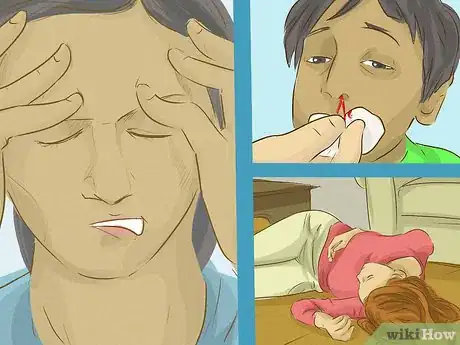





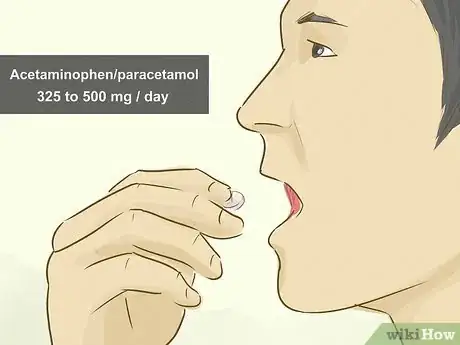



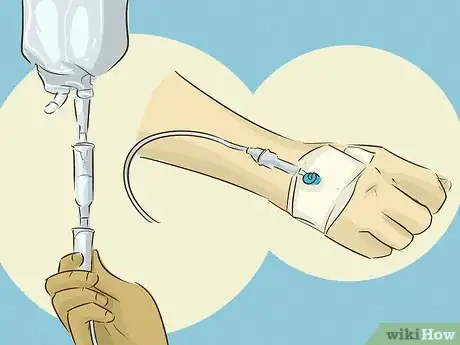










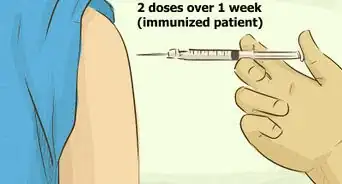
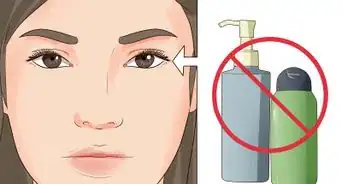




















































Medical Disclaimer
The content of this article is not intended to be a substitute for professional medical advice, examination, diagnosis, or treatment. You should always contact your doctor or other qualified healthcare professional before starting, changing, or stopping any kind of health treatment.
Read More...